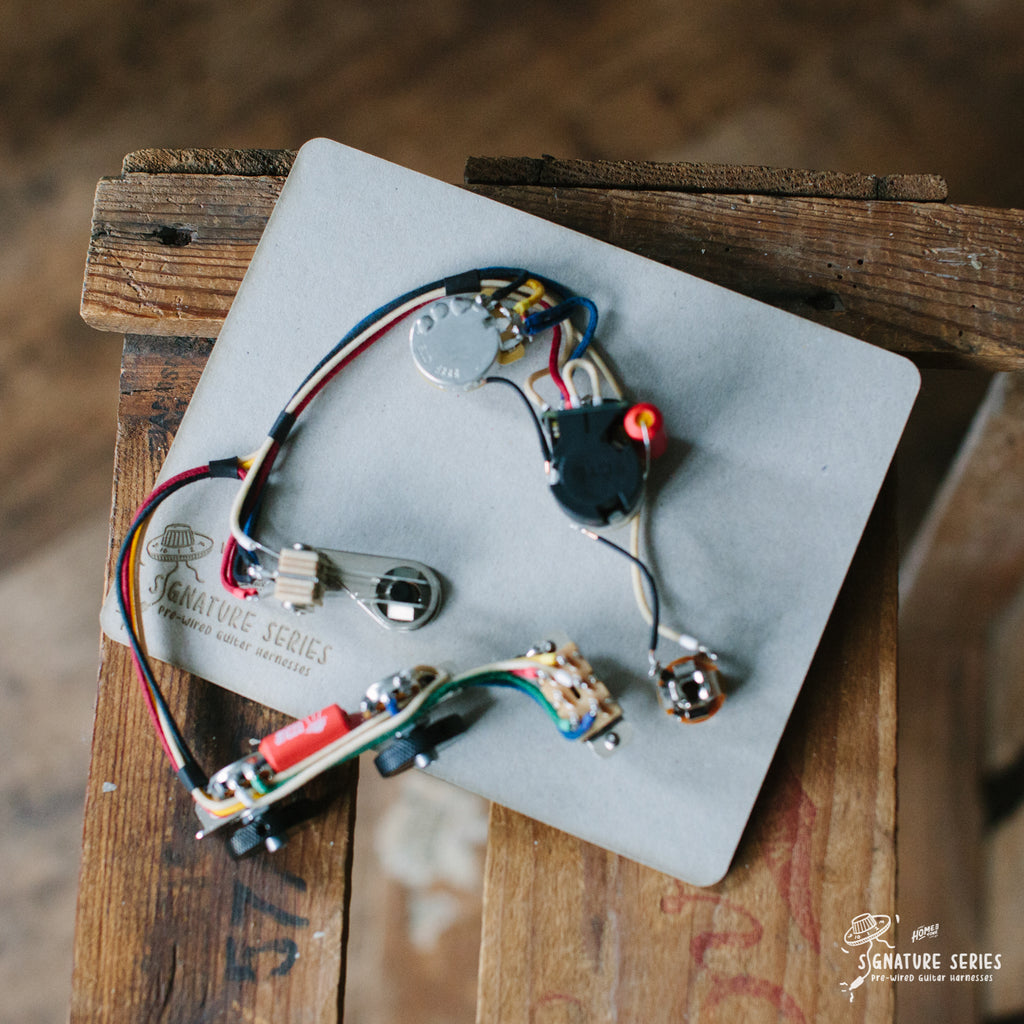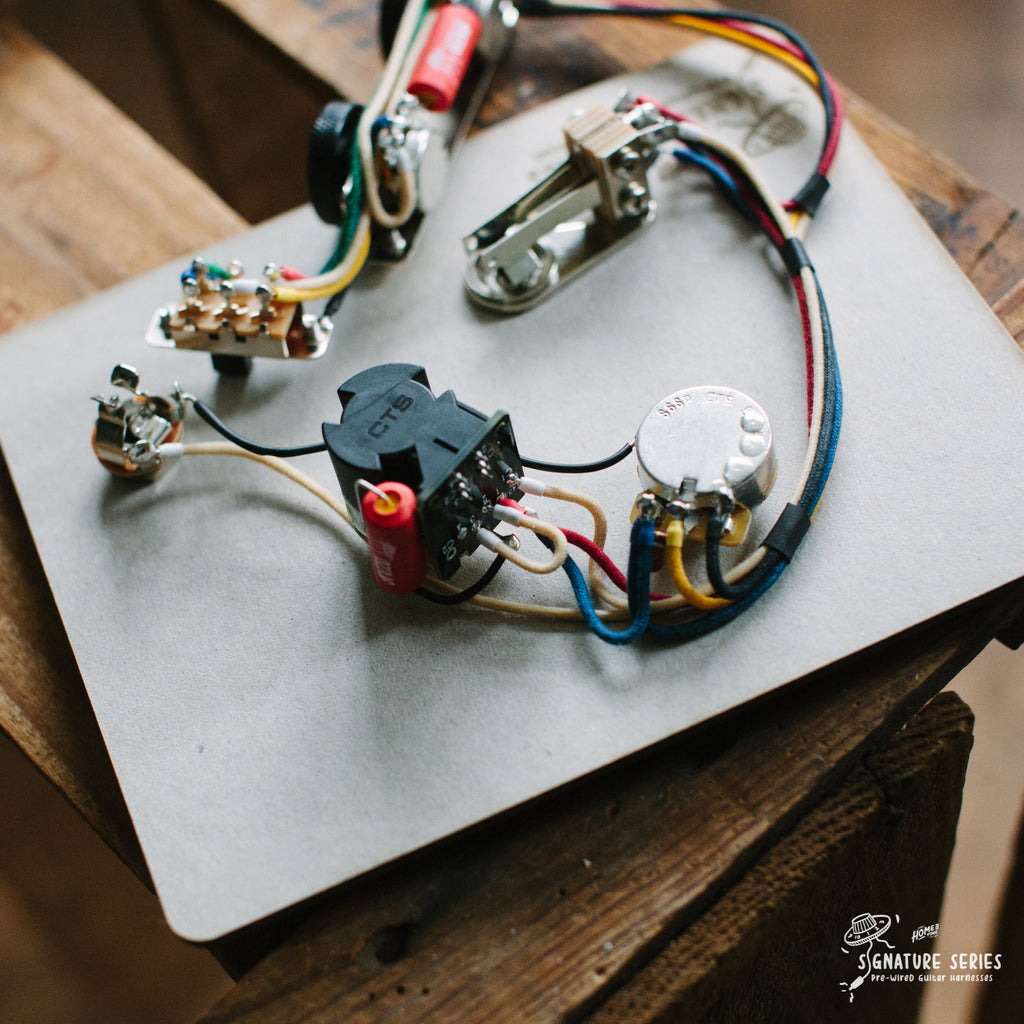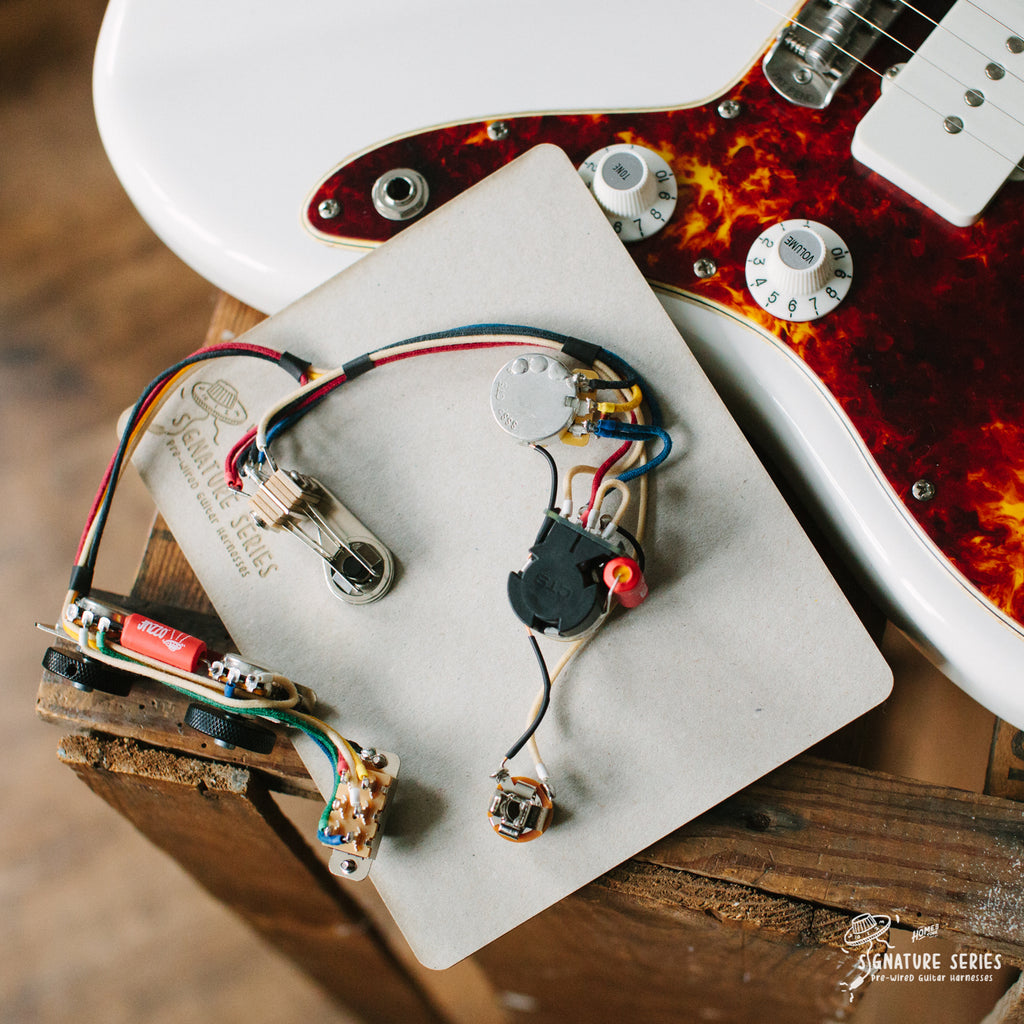Pre-Wired Guitar wiring harness | Full Jazzmaster kit Series Mod | Right Handed
£128.49
Order times
I usually make harnesses to order, due to the variety of spec options that could be chosen across the whole range. The current turnaround time for a Jazzmaster harness order is around 5-7 working days depending on quantity of orders in at the time and your order will be updated accordingly when it is dispatched. This turnaround time doesn't include the transit time. Thanks for your patience whilst I get your harness made.
Description
It's no secret that I love Jazzmasters. From the comfort of the offset body shape, to the intuitive vibrato and ultimately, the sound.
I was recently asked to make a couple of wiring looms for Smitty Custom Guitars, where their customer had asked for essentially regular JM wiring layout but with a 3 way blade switch, a kill switch and a push/pull to engage the two pickups in series. The latter choice I really liked and after wiring up those I decided to do a little testing and offer it as part of my JM wiring options. I liked it that much I now have it installed on my own jazzmaster, as you get the normal/traditional JM controls and layout with the added benefit of an extra, really use-able tone with the series mod.
It is essentially a regular JM loom, but the lead circuit tone pot is replaced by a push/pull pot. In the ‘down’ regular position you can enjoy a traditional JM control layout, but pull the tone pot up and you will put your neck and bridge pickups together in series. Resulting in a bigger, beefier and all round monster tone!
There are a couple of things to note though, most importantly is the pot spec. I much, much prefer the CTS 450 series push/pull pots over any other P/P pot on the market, so only want to use those in this kit, but sadly no one yet commissions those in 1MEG, so next best thing is to go with 500k. So please note this spec kit isn’t available with 1MEG lead circuit pots, only with 500k or if you prefer, I can also do 250k.
Also, due to some minor limitations of the simple DPDT switch included as part of a CTS push/pull pot, when you pull ‘up’ the pot and engage the series mode, this will override whatever position on the main pickup selector toggle switch you are in. So if you’re simply playing in lead circuit bridge pickup position for example, then pull up the tone pot engaging the series switch, it will automatically engage the neck/bridge series mode. Pop it back down and it’ll hop back to bridge only again for example. To be honest, in testing on my demo JM I actually preferred this. As the prospect of having to flick the pickup selector switch to the middle, then having to pull up the tone pot was extra hassle in use in my opinion. Plus, I would add that you also get the benefit of a rhythm circuit series mode! Those familiar with a JM rhythm circuit will know that when in that circuit only your neck pickups is active. Well pull up the series switch and you’ll be able to add the bridge pickup in series, in the rhythm circuit! Which sounds quite different to the lead circuit series mode due to the different pot and resistor values between the two circuits. So these experiments and results were a nice blessing in disguise really and have been really happy with the sounds and ease of use.
Pot value options and treble bleed?
Traditionally, vintage (and some new vintage correct models) were supplied with 1MEG Linear taper volume pots in the lead circuit (whilst still having an audio taper pot in the tone position). But as noted above, I am unable to source CTS 450 series push/pull pots in 1MEG, so have opted to offer this kit with 500k pot values in the lead circuit predominantly, but also with the choice of 250k too.
500k is still a popular choice for many Jazzmaster players, who perhaps don't like the shrill, bright nature of 1MEG pots or the way 1MEG pots can sometimes roll off too. So you can still achieve some JM tone with the 500k pots, but it does tame the top end a little. Also, If you have chosen a different set of pickups, like humbuckers or P90s perhaps, then this will be a perfect option for those. These are audio taper only.
It has become a popular choice recently to install much lower value 250k pots in the lead circuit also. I have decided to list it as an option now after some feedback from a good customer whom ordered it with this spec and loved the results.
Cap value options
Similarly to the choices between pots, I also offer the choice of lead circuit tone capacitor value. Traditionally Jazzmasters with 1MEG lead circuit pots were paired with a .033uF tone capacitor. So if you're looking for traditional/vintage style specs, this may well be the choice for you.
But if you are perhaps going for 500k or 250k pots, then I also offer a .022uF cap value. Simply put, a .022uF will sound a little brighter than a .033uF cap and is a very popular pairing for 500k pots or 250k pots (as well as a popular choice for humbuckers or P90s for example if your JM has alternative pickup types).
Installing
I have intended for my wiring harnesses to be as simple as possible to install to your Jazzmaster, as well as writing in depth fitting guides, how-to instructions documenting the step by step process as well as a simple to follow wiring diagram.
It will be a 'drop-in' install for USA spec Jazzmasters, but for far Eastern build models, or alternative brand replica models then it may require modification. The parts I use, in particular the pots, are CTS branded pots which are imperial measurements. If you're fitting this harness to a far east built variant for example such as a Squier or similar, then you may have to widen the holes in the control plate to accommodate for these imperial measurement pots. Or alternatively, purchase a new control plate that is already suited to the US spec components.
As the push/pull pot sits deeper than a standard pot, it may also be worth double checking the cavity depth in your specific Jazzmaster to ensure it will fit this deeper pot size. I tested this wiring loom spec in my Squier JM and the fit was fit for cavity depth. But at a minimum, it will need a cavity depth of 31mm for reference.
For reference, the CTS pots I use in this harness have a shaft diameter of 9.52mm.
You may also require new control knobs to fit the CTS pot 'split shaft' spline diameter of 5.95mm with 24 splines (push fit style control knobs). The main pickup selector switch is a Switchcraft item which requires an imperial threaded/sized switch tip. Smaller metric threaded switch tips, like those on a squier for example, will not swap over to this so you may also need a new switch tip.
If you do require US spec control knobs or switch tips, we do carry a selection of popular options in stock and they can be viewed in the hardware & plastic hardware categories on the store.
I would also note here, that soldering the pickup wires onto the tighter push/pull pot might be tricky for some installers. If you are well acquainted with a soldering iron, you'll sail it I'm sure, but if you a new to soldering, I would perhaps recommend having a trusted local tech install this kit for you to ensure no damage is caused to the components and it all functions correctly.
The template board I make my harnesses on, was taken from measurements of a USA built Fender Jazzmaster. So here are some of the main centre to centre measurements between components to help ensure a good fit into your Jazzmaster. I do allow for some give in the wire lengths though to help with a comfortable fit -
Rhythm circuit slide switch (centre) to centre of rhythm circuit volume pot wheel - 40mm
Centre to centre of rhythm circuit pot wheels - 45mm
Centre to centre of rhythm circuit bracket mounting screws - 67mm
(Wire routing follows standard Jazzmaster body cavities from rhythm circuit to lead circuit section)
Centre of 3 way toggle switch to master volume pot - 11.5cm
Centre of master volume pot to master tone pot - 5.2cm
Centre of master tone pot to jack socket - 6cm
Specs
- Choice of lead circuit pot values/specs:
CTS '450' Series 500k or 250k audio taper (Volume)
CTS '450' Series 500k or 250k audio taper push/pull tone pot (lead circuit)
- SoZo .033uF Mustard tone capacitor in the lead circuit (or choice of .022uF value)
- .022uF 'Yellow Mustard' type tone capacitor in the rhythm circuit
- Gavitt USA made multi coloured cloth covered 22AWG wire
- 20AWG Tinned copper ground
- Switchcraft right angle 3 way toggle switch
- Switchcraft on/on slide switch
- Right angle rhythm circuit mounting bracket
- 2x Roller wheel control knobs for ryhytm circuit
- 1x Alpha 1MEG mini pot
- 1x Alpha 50k mini pot
- Pure Tone multi contact jack socket
- Soldered using R-Tech Premium Lead-Free (Sn95.5Ag3.9Cu0.6) 22swg Solder wire
RoHS Compliant
Please note - wiring kit does not include new control knobs/switch tip/control plate etc but does include the pot/jack mounting nuts and washers and switch mounting screws/nut.
Why these spec parts over others available?
Simply put, component choice has been one of the most important parts of my product development. I have worked on guitars for many years, and built these kits professionally since 2015, and as a result have been able to see and experience working on the majority of components available on the market. In my findings, A/B testing and more, I have found the components I decided on for my Signature Series to be the most reliable, best tolerance and great functioning parts to use to help customers get the most out of their instruments. I use CTS '450' series premium spec pots as they have a tight tolerance, and will consistently provide me with accurate value, as well as very solid build quality. I use trusty 'Mustard' style polyester film 'tone' capacitors as in my opinion they simply can't be beat for great value, solid construction, solid lead-outs, super tight tolerances and reliable tone/function. I would personally much rather use a trusty Mustard for example over something like a paper in oil, as from experience that are so much more reliable to use. This is from carrying out a lot of A/B testing, both tonally, as well as armed with the multi-meter for testing values and actual tolerances, as well as handling them to test construction quality for long lasting reliability in use. I use the brilliant 'Pure Tone' Multi Contact Jack sockets as they are incredibly reliable, due to their additional contact points for both tip and sleeve. I use CRL, Oak and Switchcraft brand switches across the range as these are built very well, with care will last for many years to come and have long since provided me with reliable use professionally. All kits are wired up with quality USA made Gavitt wire, it's great to work with, super consistent gauge and provides me with a very reliable quality item for my kits. I totally understand that with anything guitar, it is subjective, but I have, with an open mind, thoroughly tested a broad variety of components over the years and these have all become the items I trust to use every day.
Harness FAQ's
I've been proudly making, developing and installing my pre-wired guitar harnesses since the beginning of the Home of Tone back in 2015 (time flies when you're having fun right!). Although I feel I do my best in covering as much information as possible across the various product listings, fitting guides, wiring diagrams and more, I thought it might be helpful to put together an FAQ's page that covers some of the general additional questions I get asked. You can view these Harness FAQ's HERE
'Ground Bug' deal!
Looking forward to installing your new wiring, but a little worried about making the ground connections to the pot casings? First time soldering and hear the horror stories of frying pots, or just simply want to neaten up your installs? Then the awesome 'Ground Bug' will help with any of these concerns, beginner or pro modders alike. The Ground Bug is a pot washer that fits between the pot casing and the pickguard/body and has a number of lugs (much like with the main signal connections on the pot for example) to which you can very easily solder your ground wire connections too. Completely removing the worry and risk of soldering a pot casing, something I know many guitarists complain about having to learn to do.
I have been stocking Ground Bugs for a while, and they really are the perfect match for a pre-wired harness as they further help you with your installs. So I have set up a 10% off Ground Bug deals when purchased with a Home of Tone Signature Series pre-wired harness. This is an automatic discount code, so all you need to have is a Signature Series kit, and a Ground bug in your cart, and the discount will automatically be applied to the bug for you! Click HERE to view the Ground Bug listing
Do you make custom harnesses?
I'm afraid I do not offer a custom harness service. Only kits developed, tested and listed on my website are the available kits. So no custom schematics etc. If you happen to be local to my office, then I do carry out custom work in house, but in regards to shipped out pre-wired harnesses I do not offer custom kits. I am however happy to use different pot values or cap values within reason if you have a specific requirement that differs to the specs listed above. If this is relevant to yourself then please get in touch to discuss further to ensure the request is possible.
Order times
I usually make harnesses to order, due to the variety of spec options that could be chosen across the whole range. The current turnaround time for a Jazzmaster harness order is around 5-7 working days depending on quantity of orders in at the time and your order will be updated accordingly when it is dispatched. This turnaround time doesn't include the transit time. Thanks for your patience whilst I get your harness made.
Description
It's no secret that I love Jazzmasters. From the comfort of the offset body shape, to the intuitive vibrato and ultimately, the sound.
I was recently asked to make a couple of wiring looms for Smitty Custom Guitars, where their customer had asked for essentially regular JM wiring layout but with a 3 way blade switch, a kill switch and a push/pull to engage the two pickups in series. The latter choice I really liked and after wiring up those I decided to do a little testing and offer it as part of my JM wiring options. I liked it that much I now have it installed on my own jazzmaster, as you get the normal/traditional JM controls and layout with the added benefit of an extra, really use-able tone with the series mod.
It is essentially a regular JM loom, but the lead circuit tone pot is replaced by a push/pull pot. In the ‘down’ regular position you can enjoy a traditional JM control layout, but pull the tone pot up and you will put your neck and bridge pickups together in series. Resulting in a bigger, beefier and all round monster tone!
There are a couple of things to note though, most importantly is the pot spec. I much, much prefer the CTS 450 series push/pull pots over any other P/P pot on the market, so only want to use those in this kit, but sadly no one yet commissions those in 1MEG, so next best thing is to go with 500k. So please note this spec kit isn’t available with 1MEG lead circuit pots, only with 500k or if you prefer, I can also do 250k.
Also, due to some minor limitations of the simple DPDT switch included as part of a CTS push/pull pot, when you pull ‘up’ the pot and engage the series mode, this will override whatever position on the main pickup selector toggle switch you are in. So if you’re simply playing in lead circuit bridge pickup position for example, then pull up the tone pot engaging the series switch, it will automatically engage the neck/bridge series mode. Pop it back down and it’ll hop back to bridge only again for example. To be honest, in testing on my demo JM I actually preferred this. As the prospect of having to flick the pickup selector switch to the middle, then having to pull up the tone pot was extra hassle in use in my opinion. Plus, I would add that you also get the benefit of a rhythm circuit series mode! Those familiar with a JM rhythm circuit will know that when in that circuit only your neck pickups is active. Well pull up the series switch and you’ll be able to add the bridge pickup in series, in the rhythm circuit! Which sounds quite different to the lead circuit series mode due to the different pot and resistor values between the two circuits. So these experiments and results were a nice blessing in disguise really and have been really happy with the sounds and ease of use.
Pot value options and treble bleed?
Traditionally, vintage (and some new vintage correct models) were supplied with 1MEG Linear taper volume pots in the lead circuit (whilst still having an audio taper pot in the tone position). But as noted above, I am unable to source CTS 450 series push/pull pots in 1MEG, so have opted to offer this kit with 500k pot values in the lead circuit predominantly, but also with the choice of 250k too.
500k is still a popular choice for many Jazzmaster players, who perhaps don't like the shrill, bright nature of 1MEG pots or the way 1MEG pots can sometimes roll off too. So you can still achieve some JM tone with the 500k pots, but it does tame the top end a little. Also, If you have chosen a different set of pickups, like humbuckers or P90s perhaps, then this will be a perfect option for those. These are audio taper only.
It has become a popular choice recently to install much lower value 250k pots in the lead circuit also. I have decided to list it as an option now after some feedback from a good customer whom ordered it with this spec and loved the results.
Cap value options
Similarly to the choices between pots, I also offer the choice of lead circuit tone capacitor value. Traditionally Jazzmasters with 1MEG lead circuit pots were paired with a .033uF tone capacitor. So if you're looking for traditional/vintage style specs, this may well be the choice for you.
But if you are perhaps going for 500k or 250k pots, then I also offer a .022uF cap value. Simply put, a .022uF will sound a little brighter than a .033uF cap and is a very popular pairing for 500k pots or 250k pots (as well as a popular choice for humbuckers or P90s for example if your JM has alternative pickup types).
Installing
I have intended for my wiring harnesses to be as simple as possible to install to your Jazzmaster, as well as writing in depth fitting guides, how-to instructions documenting the step by step process as well as a simple to follow wiring diagram.
It will be a 'drop-in' install for USA spec Jazzmasters, but for far Eastern build models, or alternative brand replica models then it may require modification. The parts I use, in particular the pots, are CTS branded pots which are imperial measurements. If you're fitting this harness to a far east built variant for example such as a Squier or similar, then you may have to widen the holes in the control plate to accommodate for these imperial measurement pots. Or alternatively, purchase a new control plate that is already suited to the US spec components.
As the push/pull pot sits deeper than a standard pot, it may also be worth double checking the cavity depth in your specific Jazzmaster to ensure it will fit this deeper pot size. I tested this wiring loom spec in my Squier JM and the fit was fit for cavity depth. But at a minimum, it will need a cavity depth of 31mm for reference.
For reference, the CTS pots I use in this harness have a shaft diameter of 9.52mm.
You may also require new control knobs to fit the CTS pot 'split shaft' spline diameter of 5.95mm with 24 splines (push fit style control knobs). The main pickup selector switch is a Switchcraft item which requires an imperial threaded/sized switch tip. Smaller metric threaded switch tips, like those on a squier for example, will not swap over to this so you may also need a new switch tip.
If you do require US spec control knobs or switch tips, we do carry a selection of popular options in stock and they can be viewed in the hardware & plastic hardware categories on the store.
I would also note here, that soldering the pickup wires onto the tighter push/pull pot might be tricky for some installers. If you are well acquainted with a soldering iron, you'll sail it I'm sure, but if you a new to soldering, I would perhaps recommend having a trusted local tech install this kit for you to ensure no damage is caused to the components and it all functions correctly.
The template board I make my harnesses on, was taken from measurements of a USA built Fender Jazzmaster. So here are some of the main centre to centre measurements between components to help ensure a good fit into your Jazzmaster. I do allow for some give in the wire lengths though to help with a comfortable fit -
Rhythm circuit slide switch (centre) to centre of rhythm circuit volume pot wheel - 40mm
Centre to centre of rhythm circuit pot wheels - 45mm
Centre to centre of rhythm circuit bracket mounting screws - 67mm
(Wire routing follows standard Jazzmaster body cavities from rhythm circuit to lead circuit section)
Centre of 3 way toggle switch to master volume pot - 11.5cm
Centre of master volume pot to master tone pot - 5.2cm
Centre of master tone pot to jack socket - 6cm
Specs
- Choice of lead circuit pot values/specs:
CTS '450' Series 500k or 250k audio taper (Volume)
CTS '450' Series 500k or 250k audio taper push/pull tone pot (lead circuit)
- SoZo .033uF Mustard tone capacitor in the lead circuit (or choice of .022uF value)
- .022uF 'Yellow Mustard' type tone capacitor in the rhythm circuit
- Gavitt USA made multi coloured cloth covered 22AWG wire
- 20AWG Tinned copper ground
- Switchcraft right angle 3 way toggle switch
- Switchcraft on/on slide switch
- Right angle rhythm circuit mounting bracket
- 2x Roller wheel control knobs for ryhytm circuit
- 1x Alpha 1MEG mini pot
- 1x Alpha 50k mini pot
- Pure Tone multi contact jack socket
- Soldered using R-Tech Premium Lead-Free (Sn95.5Ag3.9Cu0.6) 22swg Solder wire
RoHS Compliant
Please note - wiring kit does not include new control knobs/switch tip/control plate etc but does include the pot/jack mounting nuts and washers and switch mounting screws/nut.
Why these spec parts over others available?
Simply put, component choice has been one of the most important parts of my product development. I have worked on guitars for many years, and built these kits professionally since 2015, and as a result have been able to see and experience working on the majority of components available on the market. In my findings, A/B testing and more, I have found the components I decided on for my Signature Series to be the most reliable, best tolerance and great functioning parts to use to help customers get the most out of their instruments. I use CTS '450' series premium spec pots as they have a tight tolerance, and will consistently provide me with accurate value, as well as very solid build quality. I use trusty 'Mustard' style polyester film 'tone' capacitors as in my opinion they simply can't be beat for great value, solid construction, solid lead-outs, super tight tolerances and reliable tone/function. I would personally much rather use a trusty Mustard for example over something like a paper in oil, as from experience that are so much more reliable to use. This is from carrying out a lot of A/B testing, both tonally, as well as armed with the multi-meter for testing values and actual tolerances, as well as handling them to test construction quality for long lasting reliability in use. I use the brilliant 'Pure Tone' Multi Contact Jack sockets as they are incredibly reliable, due to their additional contact points for both tip and sleeve. I use CRL, Oak and Switchcraft brand switches across the range as these are built very well, with care will last for many years to come and have long since provided me with reliable use professionally. All kits are wired up with quality USA made Gavitt wire, it's great to work with, super consistent gauge and provides me with a very reliable quality item for my kits. I totally understand that with anything guitar, it is subjective, but I have, with an open mind, thoroughly tested a broad variety of components over the years and these have all become the items I trust to use every day.











